Your tomatoes will grow better- and healthier- if they are off the ground. Here’s 5 ways to stake tomatoes that are easy to do and will keep your tomato plants healthy and producing.
Tomatoes are the #1 vegetable planted in my garden (or is it a fruit?). We can tomato sauce, ketchup, whole tomatoes, salsa, etc. so we plant a lot of tomato plants each year. If you aren’t careful tomatoes can get out of hand in a hurry- so strong staking or trellising is a must to keep them healthy and off the ground.
This site contains affiliate links. If you make a purchase using one of these links, I may earn a commission. Please see my disclosure page for more information about cookies collected and our privacy policy.
If you shop your local garden center you have no doubt come across the tomato cage- a cone shaped, wire cage meant to hold up your precious tomatoes. I used these for one year before giving up on them and their habit of toppling over as soon as the plant gained a little weight.
Luckily, those little wire cones aren’t your only choice! Here are 5 different ways you can stake tomatoes to keep them happy, healthy and growing strong.
Are you ready to plant the perfect companion planted garden? Check out my Companion Planting Guide and Binder for all of the most important companion planting information at your fingertips. Stop googling, and start planting!
5 Ways to Stake Tomatoes
Tomato staking is super important. In fact, improper support is one of the common Tomato Growing Mistakes beginners make.
Here are just 5 ways to support your tomatoes as they grow.
1. The Tomato Cage
There are a lot of cage options out there that work much better than the cheap, flimsy cones. You can build your own using strong fencing and wooden or metal posts. Or you can buy pre-made tomato cages.
This is a good option if you only grow a few tomato plants each year and don’t want to have to continuously tie or train your tomatoes. It can get expensive if you grow a large number of plants though. You can find a how-to on building your own, inexpensive tomato cage on Old World Garden Farms.
2. The Single Stake
This has been my go-to tomato support option for years. Simply drive a stake into the ground near your plant and gently tie the stem to the stake using twine or yarn, and repeat as the stems grow. This method works best if you are pulling off the suckers to leave one main stem.
I usually pick the suckers for a few weeks before I get overwhelmed and give up! So as my plants get larger and bushier I simply loop the string around the entire plant, capturing the suckers and all- effectively making a “twine cage” around the plant.
You can use what you have on hand as a stake- t-posts, rebar, bamboo, wooden posts.
I use a combination of metal t-posts, rebar and bamboo. Make sure you match your stake to your plant- heavy growing indeterminate types should have taller stronger stakes, while shorter, determinate varieties should be fine with wood or bamboo.
Related Reading: 5 Ways to Trellis Your Cucumbers!
3. The Florida Weave
We live down the road from a very large commercial tomato farm. And while I don’t admire their growing practices, I do admire their trellis! They use a system called The Florida Weave, which is essentially weaving tomato twine between posts and plants to hold up plants and fruit.
As with a single stake, you will have to continue to run the twine as the plants grow. With our tomato plant numbers reaching past the 250 mark this year, I have decided to use this method to save on the number of stakes required in the garden. The Garden Betty has a nice post on using this method.
Keep track of all your tomato varieties in my Yearly Garden Planner! It’s got everything you need for a successful garden!
4. Vertical String Trellis
This is a common support method for tomatoes grown in greenhouses, but it can also be utilized in the garden as well. You will need to make some sort of frame to support the strings – such as an A-Frame.
Tie the strings to the top bar of the frame and then either loop it around the root ball of your plant or tie it to a bottom support bar. Then simply wrap the string around the plant as it grows (you can also use tomato clips).
With this method you will also have to keep the plant pruned to one main stem, but it is a good method for those without a lot of space.
Related Reading: How to Grow Vertically in Your Garden!
5. The Fence Panel
Wire fencing can also make a great support your tomato plants. We’ve used this method a couple times over the years when I replace my withering peas with tomatoes.
It’s pretty simple to construct- just pound 2 metal t-posts in the ground and stretch your wire fencing between them. You can do a long stretch of fence, placing posts every 6-8 ft. Then tie up the stems with twine or string just as you would if you were using a single stake. This way is nice if you can’t or don’t want to keep up with the suckers as you can just tie them up to the fence as well.
We us a combination of all of these in our garden- fencing panels used to be my favorite, but now that we grow hundreds of tomatoes each year, the Florida weave is growing on me. Are you struggling to grow tomatoes in your garden?
You May Also Like:
The Best Tomato Companion Plants for Your Vegetable Garden
How to Control Aphids Using Companion Planting
The Best Essential Oils for Gardening

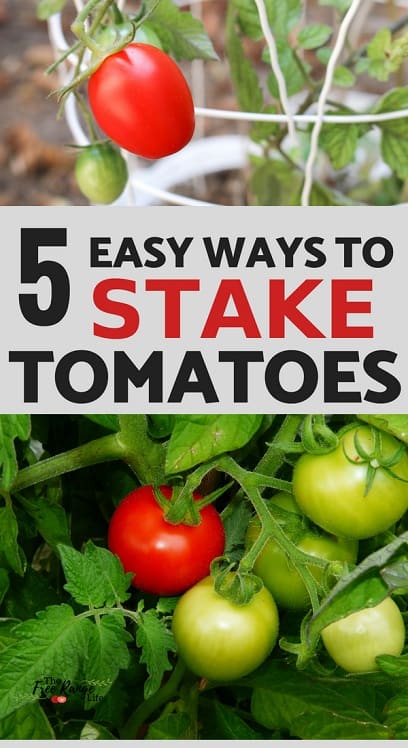
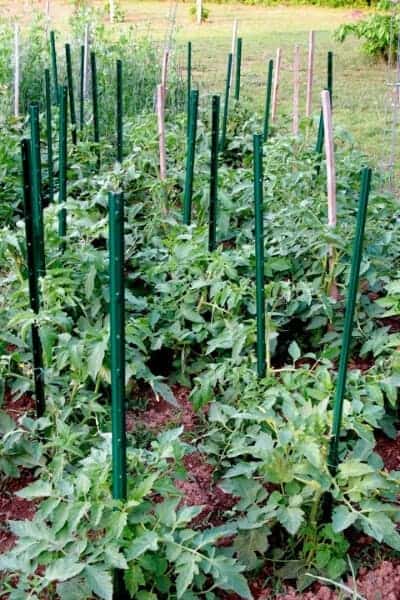
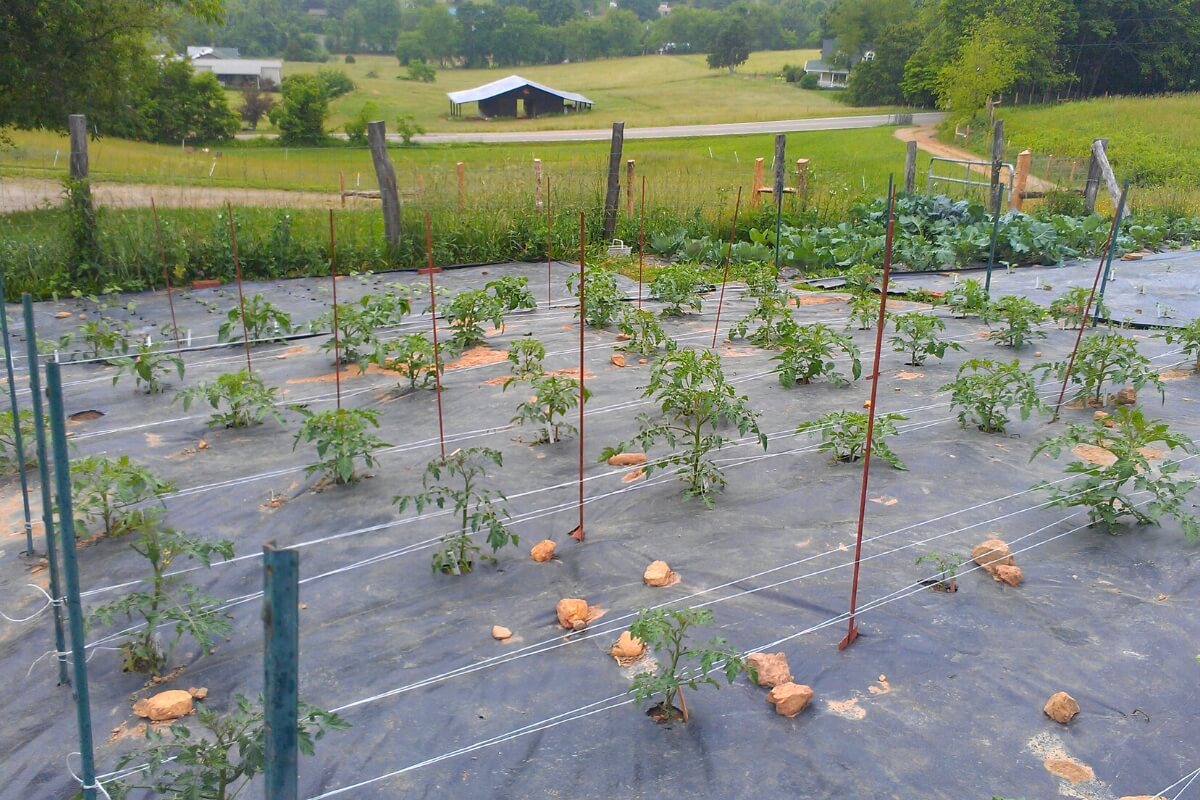
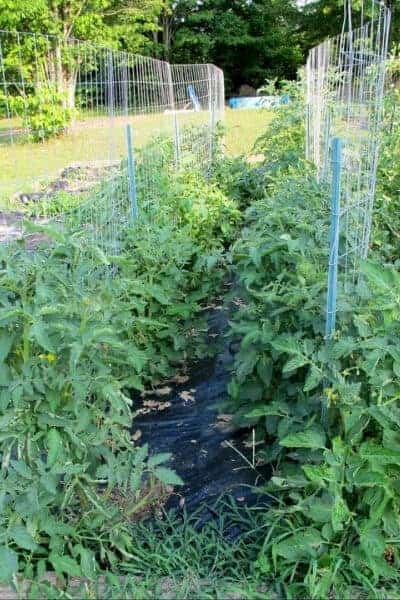
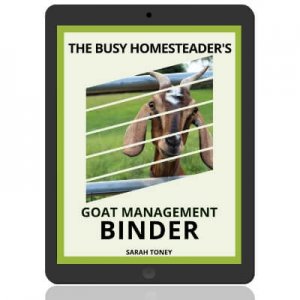
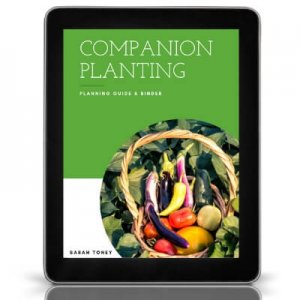
This post is such perfect timing for me! I was just researching ways to trellis tomato plants without a tomato cage. I have quite a collection of tomato cages I’ve acquired over the years but this year I have well over 60 tomato plants and not that many cages. We put up a fence panel yesterday to trellis our tomatillos but ran out of fencing to do that for the tomatoes. We do have a bunch of scrap wood so I think we’re going to try the single stake method. Thank you for this great post!
We plant a lot of tomatoes here, too, I’m glad I’m not the only one who gets tired and gives up removing the suckers! We stake a lot of our plants too, suckers and all, but I really like the Florida Weave idea!
It works great, but it still requires work
Another way: buy cattle panels, which are 16′ long, 5′ tall, and have 6″ square openings. Plant a row of tomatoes, and then put a cattle panel on either side of the row (so two 16′ cattle panels for one row of tomatoes). The two panels should be about 2′ apart (The cattle panels are attached here and there to a support stake….also, the panels can be attached a foot or so off of the ground, to make it taller, as the bottom 1′ of the tomato plant doesn’t need to be caged.) Then, as the tomatoes grow, add in sticks or posts that go between the two panels on either side of the plant (from one panel to the other panel) to make a cage around each plant. I just do that part as needed if one plant seems to be growing into the space of a neighboring plant. Cattle panels can be cut apart to make shorter fences (they don’t have to stay 16′ long). This system is great because it stores flat. There’s only been one time so far that I had a tomato that was too big to fit through the 6″ square opening and I had to lower it down to the ground to pull it out.
I love this idea! Putting sticks through to make cages is brilliant. I also like that it can store flat. Thanks!
Hi Jean – Thanks – your idea of using cattle panel looks great. Where can one buy cattle panel at a good price – Home Depot or Lowe’s ? Where do you get or got yours from.
We have used tepees and like them. If you have a bunch of saplings around that you don’t want, you can use them. Leave a little bit of the side branches still attached as spots for your twine to rest. Push them into the ground and tie the tops together above the plant.
I plan on trying the Florida weave this year. The posts should have been in the ground a week or two ago! It’s still not too late. Thanks for sharing these techniques.
I used cones and the square wire ones last year for the first time. They worked for a part of the year. You are right as soon as they start getting tomato heavy they bend and crumple and then they come apart at the welds. If you do use the cones I learned to put the cone in when you have the hole dug for the tomato and then back fill. Much easier then trying to stab the ends into the ground (they bend!!). I am using them this year on my peppers and eggplants and then they will go to the recycling center. I am back to the tried and true bamboo stakes. Next year I may try the weave ( i only have 8 plants – 2 Sungold, 2 Roma, 1 Mortgage Lifter, 1 yellow pear, 1 Black Krim and 1 Green Zebra)
When should you cone egg plants or peppers I didn’t think about this. I think you just gave me a idea! Thank you
I grew bigboys last year in 4’cages the cages didn’t topple but the first 4′ didn’t have a leaf.
Liked this so much I pinned and stumbled!
That’s amazing you grew over 250 tomatoes in one year! I’ve never grown my own tomatoes before, but I can’t wait to finally be able to. I had no idea they could take over so much! I will keep these techniques in mind. Thanks!
This is great information. Last year I grew a garden for the first time in many, many years. My tomatoes went crazy! I ended up with a tomato forest and I think a few trolls and fairies set up residence in there! ;) I needed some suggestions on better ways to tie up the little beasts – the tomatoes, not the trolls. Thanks. Oh, I found you on stumbleupon!
We do #5 if we have a lot of tomato plants. This year we’re taking it easy on the garden and just planted a slicer and a cherry + a whole bunch of volunteers from last year’s tomatoes.
I was planning to grow vegetables in my garden especially tomatoes. Thanks for the valuable information.
I planted the prunes that I clip an had more tomatoes
What r prunes… suckers????
I use a small action of wire fencing rolled into a tube. Placed over the plant.
I tried vertical string trellis this year and I’m rather disappointed.
It’s totally my mistake, I have to be honest but last year I had a lot more tomatoes by growing my cherry tomatoes as a bush instead of one vine. I now found a way to get more flowers on one vine but that’ ll be for next year.
I use 2 wooden/steel 7′ posts about 8′ apart. Then 4″ or 6″ square fencing wire mesh – 5′ high. A threaded steel rod between the posts at 6′ high. Tie the mesh to the rod and posts. As the tomatoes grow use twine to tie the tomatoes to the fencing. If growing bushes higher than 6′ use twine between the posts.
Suckers above 3 feet becomes flower shoots, and even suckers shows flower shoots. Then why do we remove the suckers?
my grdparents have been growning tmatoes since 1965.i have done it for 22 yrs of my life.tieing is my most dredded chore.wondering if theres any easier way.we average anywhere from 5-7,000 plants or more a yr.we we drive a stake every 2 plants,one the first tie i use a stick w an eye screw at top and right now its a piece of broken hollow fishing pole hoseclamped to the stick.i run my string through the eye,down stick through fishing pole so it comes out the bottom.i use this on the first tie.on next tie i tie off at end of the row then go stake to stake wrapping it around,get to end of the row and go up the other side.
what i don’t understand is, what about bushes that would be 12-16 feet if staked up? all of my plants grow so fast and so wild that i cannot get in to do the pruning. i get very few tomatoes. i think i’m catching on to having one trunk and going out everyday to fight suckers, but the plants simply grow too tall.
What I do for the really tall indeterminate plants, is once they get about 7 feet (my tallest t-post) I pinch off the growing tip. I tend to do well pruning early one, but once they really get growing it’s hard to keep up. So there’s always another sucker that will still grow and produce more flowers once the main stem has been pinched.
How you prune a tomato plant depends on its type. I think the trellising choice needs to begin with what kind of tomato plant you have. Indeterminate tomato plants are the kinds that grow like a vine. They are great to trellis on strings in tunnels, or strings from high places. These are the kind that you prune all the suckers, which tend to grow larger and leaf more than flower, and make a mess of things if you let them grow.
Determinate plants have been bred to branch off at the bottom more like a tree. With determinate plants its important NOT to take off all the suckers or you will reduce your crop! I choose determinate plants where I can’t trellis tomatoes on strings. I choose as tall and strong a stake as I can, and tie them once a week (I call it “tomato Tuesday” so I don’t forget). When they get larger, I do the Florida weave so that rain and wind don’t bring them down, and you can even add additional stakes to support a large plant, if needed. If the plant starts growing taller than the stake you “crown” it by pinching the top. So indeterminate are the ones where you take the suckers, determinate are the ones where you take the top.
One other tip… after accidentally strangling some tomato plants by their growing faster than I could tend to them, I switched to professional clips and I’ll never go back to tying. The clips are cheap and can be reused each year if you remove them and then put them in bleach water for a few minutes. They make different ones for determinate or indeterminate trellising. The indeterminate clips for strings… the trick is put the string in the crack of the fold so that it doesn’t slide on the string.
Cut back on the nitrogen. After the first couple of feeds, switch to a tomato plant food (red bag). It will focus on flowers and fruit.
This is my first year growing tomatoes. You all have me scared that I won’t be able to do this. I am going to try anyway wish me luck. I have learned a lot about staking from this article and feedback. I have read other articles on this subject. I hope that I have all the information to do this.
You will do fine! If you make mistakes so…. you learn.
Just follow the advice on the 2 types of plants, water and
fertilize. Keep the weeds away, oh also plant marigolds &
Chrysanthemums near them. Keeps bugs away🐛🐌🐜🦖
I use Hog panels which are 8′ long and similar in strength to cattle panels. I hang them from 7′ t-posts, just Ziptie them about a foot off the ground (I just match up the tops). Unlike the lady who commented earlier, I only ever do a single row. Start training your plants upwards with a 2′ dowel leaned up to the spot where you want them to begin climbing. As you plants climb, simply weave them in and out of the 6″ openings. This allows light and airflow all around. Raising them off the ground allows you to weed, cultivate, and pick from either side. After having perfected this method for growing tomatoes, cucumber, beans, and melons, I’ll never do it any other way.
what do you mean when you said, train the plants upwards with a 2′ dowel leaned up to the spot where you want them to begin climbing? can you explain please and thank you.
What do you have on the ground around the tomato plants in the Florida Weave photo? It looks like some type of plastic.
We use concrete reinforcing screen rolled into a cage. Very inexpensive and last several years. Ours are on their fourth year. Yes, the wire rusts, but the iron is good for the soil, and we usually tie up the fruits anyway so they don’t run.
For long runs we use cattle panels. Extremely sturdy, they can last decades. You’ll need bolt cutter to cut these if you want shorter sections.